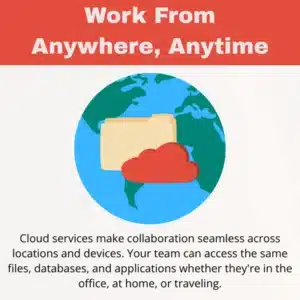Cloud technology has moved from nice-to-have to must-have for businesses of all sizes. More than 90% of companies now trust cloud providers for cloud computing services. The shift makes sense when you consider the clear advantages cloud storage delivers.
Moving to the cloud can slash IT costs while boosting team productivity. It gives your business scalability, agility, and flexibility to grow or shrink as needed. Your cloud storage keeps data more secure and accessible from anywhere. These benefits add up to real competitive edge in today’s fast-moving market.
Let’s explore the cloud computing model, cloud data storage options, performance gains, and advantages that make cloud computing essential for modern business operations.
Massive Cost Savings Through Smart Resource Use

This shift from capital expenses to operating expenses can cut your IT infrastructure costs by 30-50%. Accenture research shows that migrating to a public cloud computing deployment can lower total ownership costs by 30-40%, boosting availability. Those cost savings free up budget for core business investments.
Cloud providers handle infrastructure management using a cloud analytics solution. Your team stops spending time on server maintenance, patches, and hardware upgrades. Automatic software updates arrive without any effort from your staff. This means more time for strategic projects that drive business growth.
The pay-as-you-go model also improves resource utilization and energy efficiency across your organization. You right-size your technology spending and avoid the waste of over-provisioned systems.
Scale Up or Down in Minutes
Traditional IT setups require weeks of planning to add processing power or storage capacity. Cloud environments let you scale instantly with a few clicks. Need more compute resources for a product launch? Scale up in minutes. Traffic dies down afterward? Scale back just as quickly.
This scalability gives your business incredible flexibility. Retailers handle holiday traffic spikes without crashes. Startups launch small and expand rapidly as they grow. You always have exactly the capacity you need when you need it.
Major cloud providers operate global networks of data centers. This means you can deploy applications closer to customers for better cloud performance and lower latency. The result is faster time to market for new products and services.
IBM found that 65% of high-performing organizations credit cloud computing with reducing their development cycles. This deployment speed advantage helps you beat competitors to market with new offerings.
Enterprise-Grade Security at Small Business Prices

An Oracle survey found that security is actually the top cloud computing services benefit, cited by 60 % of executives. This beats out cost reduction and scalability as the main driver. The reason is clear when you look at resource utilization and compute resources data.
Studies show 94 % of businesses see improved security and performance after moving to cloud services. Centralized security updates reduce human error and close vulnerabilities faster, while compute resources pooling lifts resilience. You get enterprise-grade data protection and compliance tools that would cost millions to build yourself.
Cloud computing architecture includes features like virtual private networks and user-level permissions that lock down your data. The risk of insider threats actually decreases since sensitive information isn’t sitting on local devices.
Stay Online When Problems Hit
Downtime costs large businesses around $9,000 per minute in lost revenue and productivity. Cloud infrastructure in modern cloud environments uses multiple redundant servers across different locations. If one server fails, traffic automatically moves to another without users noticing.
This built-in reliability and pooled compute resources deliver availability levels that single server rooms can’t match. Most cloud platforms guarantee 99.9 % uptime or higher in their service agreements.
Disaster recovery is simpler in the cloud. Data lives across several regions. Aberdeen research says firms using cloud services fix incidents in 2.1 hours versus 8 for traditional setups.
Automated backup data systems handle the heavy lifting of business continuity planning. You avoid the massive cost of maintaining duplicate data centers while getting better protection than most on-site solutions.
Work From Anywhere, Anytime

Remote work through cloud platforms actually boosts productivity. Workers stay connected to everything they need using laptops, tablets, or smartphones. Mobility becomes a natural part of how your business operates.
Real-time collaboration tools let teams work together on documents, share dashboards, and communicate instantly. Version control problems disappear since everyone works from the same cloud-based source. You can even give clients or partners secure access to specific areas.
By 2025, an estimated 90% of businesses will rely on cloud-based collaboration software. Companies that embrace this transition early get an advantage in talent acquisition and employee happiness.
Innovation Without Big Upfront Costs
Cloud platforms offer access to cutting-edge tools like AI, machine learning, and big data analytics without huge investments. You can test new ideas quickly since the infrastructure is ready on-demand. This lowers barriers to innovation and speeds up development cycles.
Cloud services enable businesses to launch new applications 30-40% faster than traditional methods. Features like serverless computing and microservices architecture accelerate the development process. Faster time to market gives you competitive advantages in rapidly changing markets.
Research by Deloitte shows small and mid-sized cloud users make 21% more profit and grow 26% faster than non-cloud companies. Cloud migrations can boost profit growth by up to 11% year-over-year by enabling new digital products and services.
McKinsey found that innovation value from cloud computing is over five times greater than cost savings alone. The biggest payoff comes from reinventing how your business operates and serves customers.
Green IT That Saves Money Too

Google Cloud matches 100% of its electricity with renewables. AWS aims for 100% renewable energy by 2025. Accenture research shows moving to cloud infrastructure can reduce carbon emissions by up to 84% and energy usage by up to 64%.
Sharing cloud servers with other organizations means higher utilization of each machine and less electricity waste. You avoid the environmental impact of manufacturing, powering, and disposing of your own hardware.
This energy efficiency translates to lower costs while supporting your company’s sustainability goals. Customers and stakeholders increasingly value environmental responsibility, making green IT a brand advantage too.
Ready to Make the Move?
Cloud computing benefits all aspects of current corporate operations. The benefits are apparent and measurable, ranging from lower IT costs and increased security to enabling innovation and supporting sustainability goals.
The companies thriving in 2025 are those that have fully embraced cloud technology. They operate more efficiently, respond faster to opportunities, and invest their resources in growth rather than maintenance.
If your company hasn’t looked into cloud solutions yet, you’re missing out on substantial competitive benefits. Many people underestimate how easy it is to make the switch to cloud computing, especially with expert help on implementation and integration.
Don’t let outdated infrastructure hold your business back. Start your cloud journey today and unlock the efficiency, security, and innovation advantages that will drive your success for years to come.

